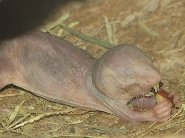Saturday 22 August 2015 Naked Mole Rat - More Than Meets The Eye
 The naked mole rat (Heterocephalus glaber) is a rodent, known for its burrowing and is indigenous to East Africa. The mole rat possesses a number of characteristics which allow it to survive in underground and harsh environments.
The naked mole rat (Heterocephalus glaber) is a rodent, known for its burrowing and is indigenous to East Africa. The mole rat possesses a number of characteristics which allow it to survive in underground and harsh environments.The average naked mole rat is between 3 to 4 inches (8 to 10 centimeters) in length and weighs between 1.1 and 1.2 ounces (30 to 35 grams). They have small eyes, poor sight, and have legs that are quite short and thin. They are also able to move backward and forward at the same quick pace and have large teeth that allow them to dip. The term "naked" comes from the fact that they have very little hair and gray-pink skin.
The species is highly adapted to situations in which oxygen is limited within tunnels of their habitat. The lungs are small and their blood is greatly able to bond oxygen. They have very low metabolic and respiration rates. During periods of drought and hunger, the metabolic can decrease further to about 25% of its normal level.
The naked mole rat lives predominantly in the dry tropical grasslands in East Africa with large concentrations being concentrated in Somalia, Kenya, and southern Ethiopia. Groups of around 80 individual mole rats (although it can be as few as 20 and as many as 200) live within a complex burrowing system within the African desert. These tunnel systems can be quite long, between two to three miles in length.
There is a complex hierarchical structure where one queen and between 1 and 3 males reproduce, the other naked mole rats are workers and sterile. Dimorphism exists between the males, two forms of workers (tunnel digging/gathering and soldiers), and the breeding males. The breeding males and the queen can keep up their relationship for several years. The queens can live for a period of between 13 and 18 years and are quite hostile towards other females. Upon the death of the queen, another female will become queen in her place.
The naked mole rat mostly eats large tubers that they find underground during their mining exhibitions. However, they are also known for eating their own fecal matter. One tuber, depending upon its size, can feed a colony for several months or years as they only eat the inside of the tuber. They leave the outer parts so that the tuber is able to regenerate.
Naked mole rats are currently not a threatened species. Although their living conditions are tough, they are a widespread species.
Naked mole rats help in cancer research, because they never get cancer (read here). You can help spreading the word about this animal by liking it on facebook
